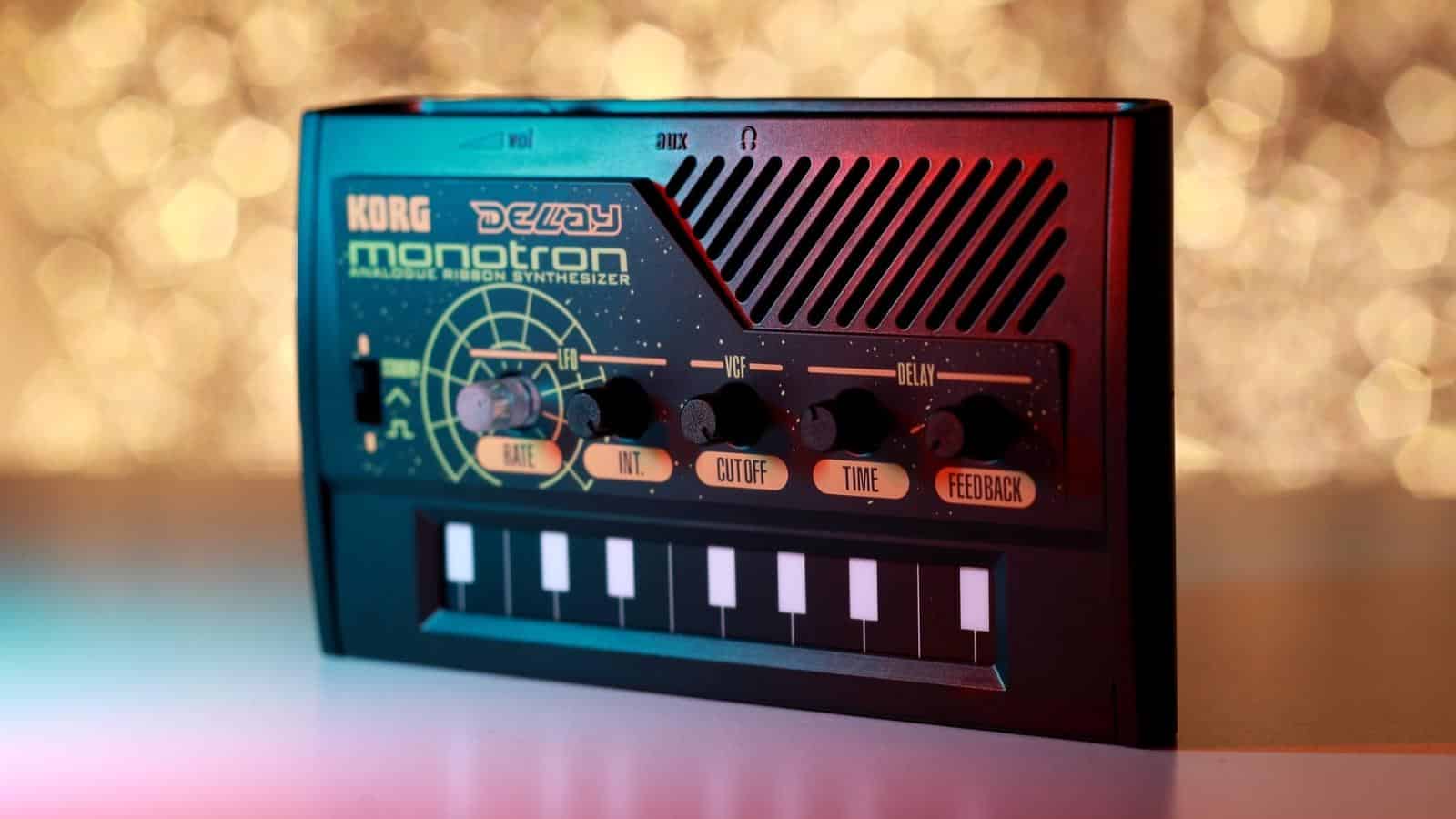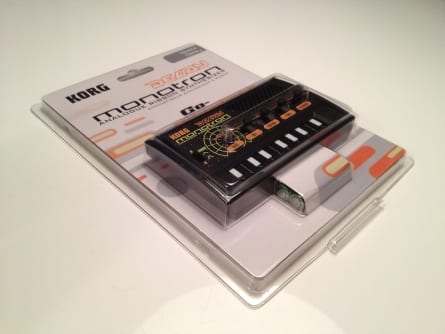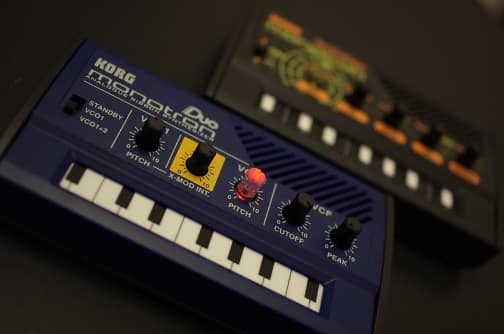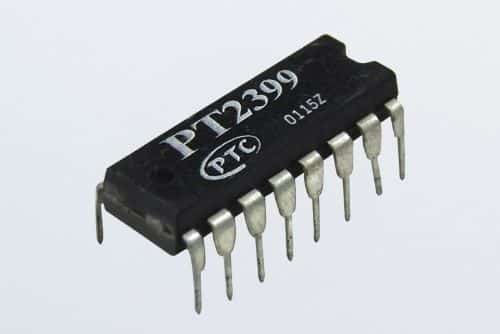
The debate between digital and analog synthesizers is an old one.
While there are digital synthesizers out in the market that give your recordings clarity, power, and vocal perfection during application, many guitarists, composers, and sound engineers still prefer analog synthesizers, in part due to the sharpness it gives to tunes.
That’s right- analog synthesizers have an edge over digital synthesizers as they send waveforms through a true circuit board in varying shapes. Each shape sounds a little different, creating raw waveforms that you can filter and envelope.
Because of this, analog synthesizers carry great customizability. Plus, some people simply love the authentic, vintage, and warm feel of real hardware.
If you lean on the side of using analog synthesizers over digital ones, chances are you’ve already looked up popular options to purchase online.
One sought-after synthesizer is the Monotron Delay- a piece of equipment suited for a variety of instruments and applications. It’s considered one of the best analog synthesizers on the market today.
But what makes the Monotron Delay so special? And is it worth the hype when it comes to design, utility, and affordability? Let’s find out.
About The Monotron Delay
1. Design
The first thing most composers and sound engineers consider when purchasing such devices is the design- and luckily, this is where Monotron Delay excels.
It has a simple, neat, and handy design with all controls visible, despite being small enough to fit into your hand and be carried around easily.
The Monotron Delay’s design is based on the original Monotron design, down to even the position of each of the five knobs. A three-way slider switch is present on the front panel.
The setup is pretty basic and easy to use- you have a ribbon controller, a headphone output, an auxiliary input, an integrated speaker, and a battery compartment on the back. The model uses a pair of AAA batteries for its energy supply.
However, if you’re used to working with analog synthesizers, especially the original Monotron and Monotron Duo you will notice some apparent differences in the controls.
Unlike Duo, the Delay doesn’t add an oscillator and modulation control key– instead, it features an additional analog-style delay circuit. It has reverse keys, a black case, and a funky space-fiction game design.
Other than that, there is some interactive lighting on the design that makes each button glow out, which improves usability to some extent.
Most people who prefer working in the dark love this device for the ambiance it gives. There are backlit buttons too. You can get the design in a few colors.
2. Utility
The Monotron Delay analog synthesizer has a wide application of features and provides excellent utility. It has a small but perfectly-built delay circut crammed inside the case that produces sharp and clear waveforms.
The VCO feature produces a reverse sawtooth wave (buzzy-sounding). The LFO produces both triangle and square waves, so you can pick the right synth for your tunes (square waves alternate between high and low voltage more).
Though it’s good to keep in mind that while the LFO can modulate VCO pitch, it can’t control the filter cutoff. As for the synthesizer ribbon, it has a four-octave range designed for FX.
The delay circuit is analog-style and sculpts the sound without tuning accuracy. You can adjust the delay time from a few milliseconds to about one full second.
Adjusting the delay time impacts the results significantly. At the shortest setting of delay time, if you keep the feedback halfway, you’ll produce a twangy sound with your device.
This sound is close to a spring reverb. This is just one example- there’s a surprising range of what settings you can do and what results you can achieve.
The synthesizer’s feedback control effectively bypasses delays you’ve set at the lowest settings, though as you crank the setting criteria up it moves slowly from the slap-back echoes to dubstep-like spacey sounds that have infinite loops/repeats.
Remember that you only make raw waveforms at first, and most of the functioning of a synthesizer is based on the filters you use to process these waveforms. You can adjust waveforms in a number of waves, like by lowering or increasing the cutoff or changing the resonance filters.
In most cases, lowering the values makes the music mellow, and increasing it produces sharper and punchier beats. The synthesizer also lets you decay, attack, release, and sustain envelopes to adjust the length of each note.
Thanks to this collection of filters, oscillators, VCO, and LFO, you can easily use the device for most of your audio engineering needs. You can set space delays that are essential for when you want to create larger-than-life and cosmic sounds.
These delays are based on the cheap PT2399 chip created by PTC. This echo processor chip isn’t really quiet and can contribute to a lot of white noise swelling.
Luckily, white noises aren’t a big deal for special effect tools like analog synthesizers, but it’s still something you should keep in mind before buying this model.
That being said, if you want clean delays that don’t create even a little noise, then this model may not be for you. The instrument is designed for dirty music (including hard EDM). You can even add a little bit of messiness and filth to the audio using the auxiliary input. This will make the external signals nastier.
In short, for usability, this synthesizer is great for both mellow tunes and EDM. There are effects on the instruments that you can play to enhance the EDM sounds.
3. Durability
Next up is durability. Now, since the Monotron Delay is a rather low-budget model packed with features, there is a small compromise on the durability.
Its body is made out of plastic, so you have to be careful while using it and avoid hitting any sensitive spots that would interfere with the device’s functioning.
It’s prone to scratching, so you must protect it from sharp objects and tools. You’ll also need to avoid falls and shocks, as the material isn’t particularly shock absorbent.
4. Potential Weaknesses
While this analog synthesizer is excellent all-around, the Monotron Delay has one small weakness- its filter section.
The synthesizer has a feedback control that transfers delayed signals back into the filter after they’ve already passed through it. This is wonderful for shaping the tone a little more before the recorded raw waveforms hit the delay circuit once more.
Unfortunately, there’s only one form of adjustment- cutoff control. There’s a lack of peak control. This peak control is used to adjust the resonance and it was present in the MS-20 low pass filter, which was a big selling point of the original Monotron.
Cranking up the resonance using this control really makes the MS filter come alive again, elevating the instrument beyond mild tone shaping. At high levels of resonance, the MS filter becomes a self-oscillating monster, which works wonders for many genres of music.
The likely reason why this feature was omitted is because of the sliders on the front– to add a resonance tool, you’d need to ditch other controls.
So to put it simply- the device is amazing and has a great filter, but it has a fixed resonance and you can’t crank it up for more oscillation.
5. Affordability
The last factor to consider before purchasing the Monotron Delay is affordability and to be honest, it’s one of the most cost-effective analog synthesizers out there. Its price range of $60-80 is simply unbeatable.
And the best part is that you’re not missing out on any special functions or parameters that other synthesizers offer. With Monotron Delay, you can create all kinds of tunes without forking over hundreds of dollars for equipment.




